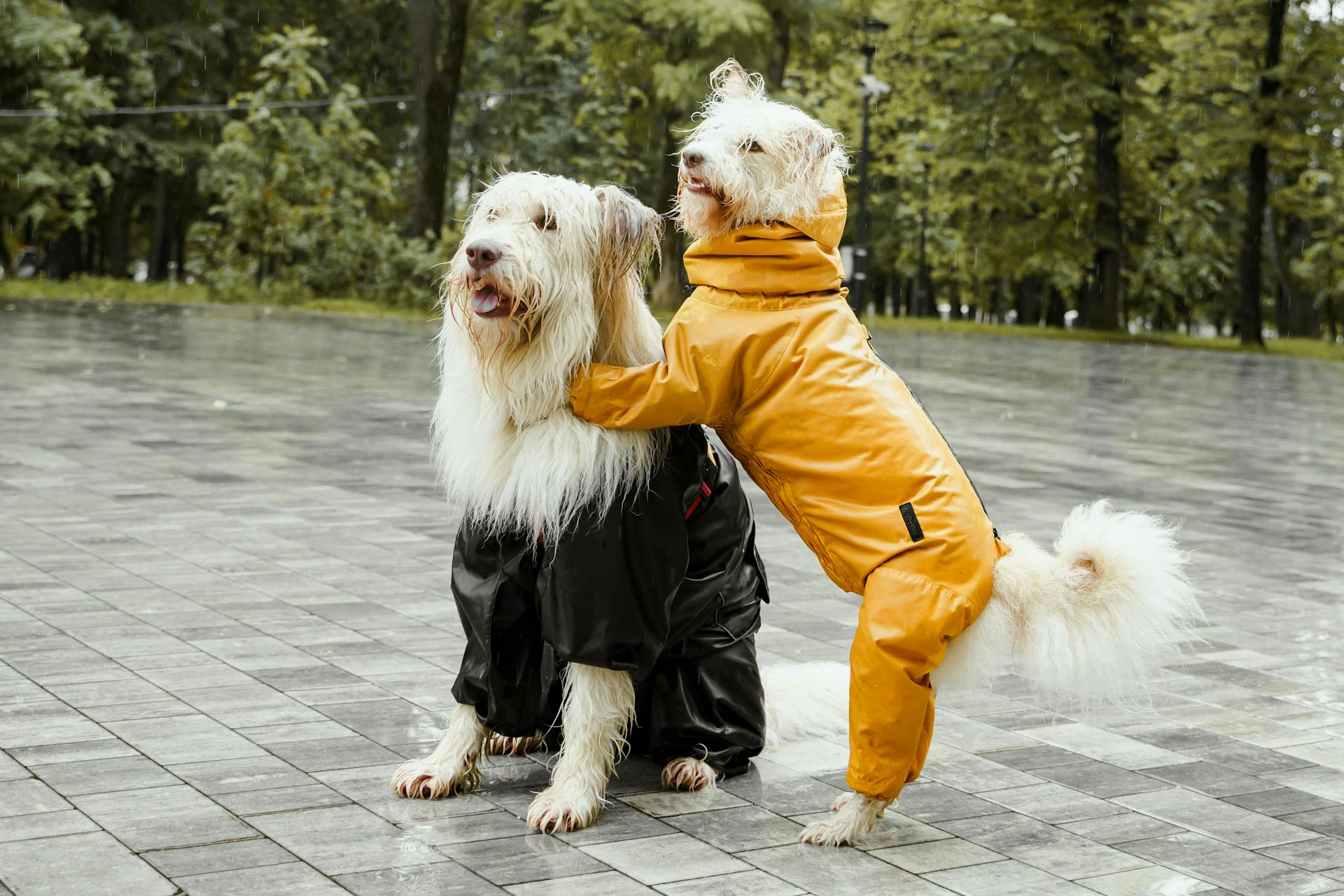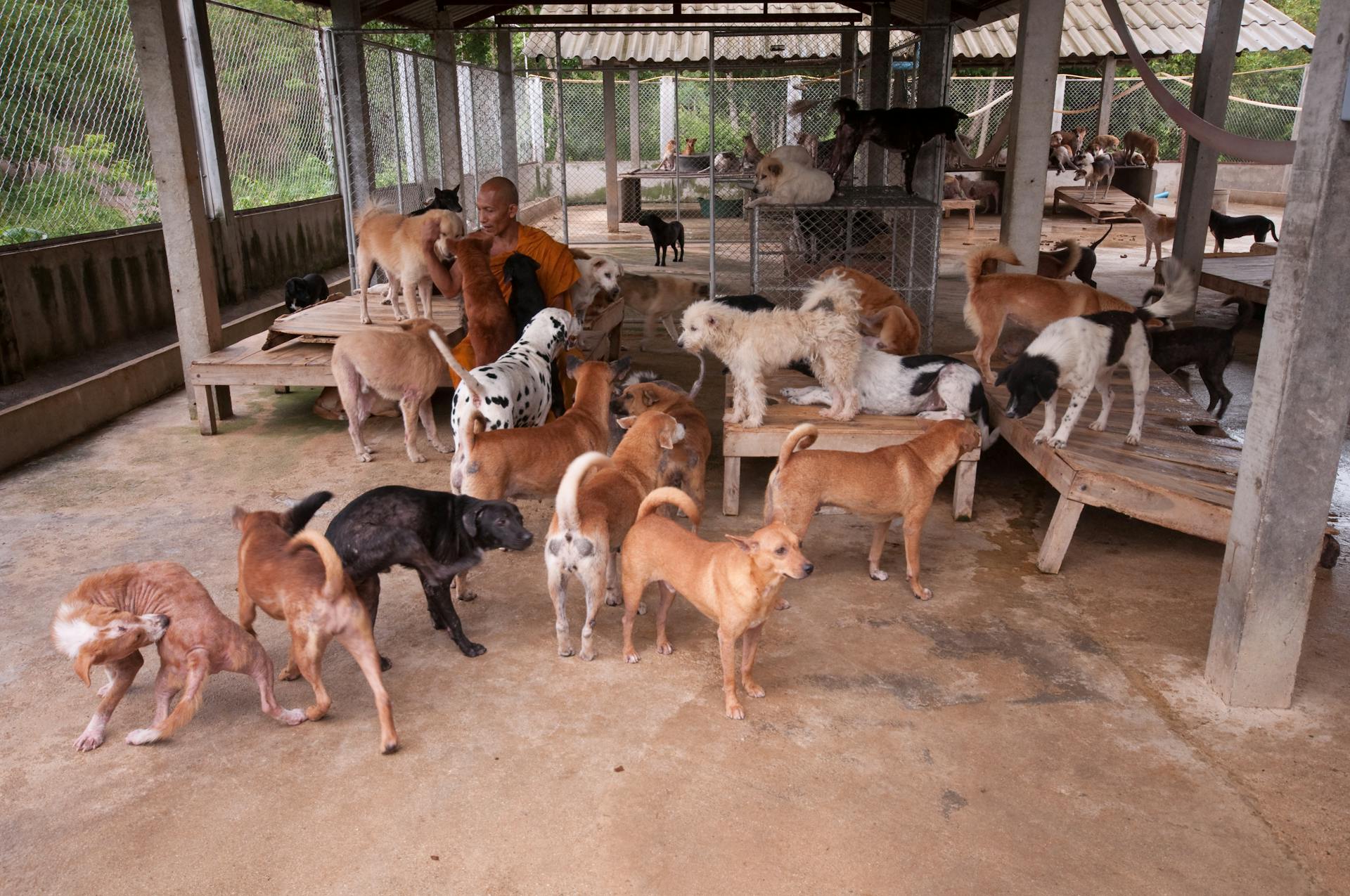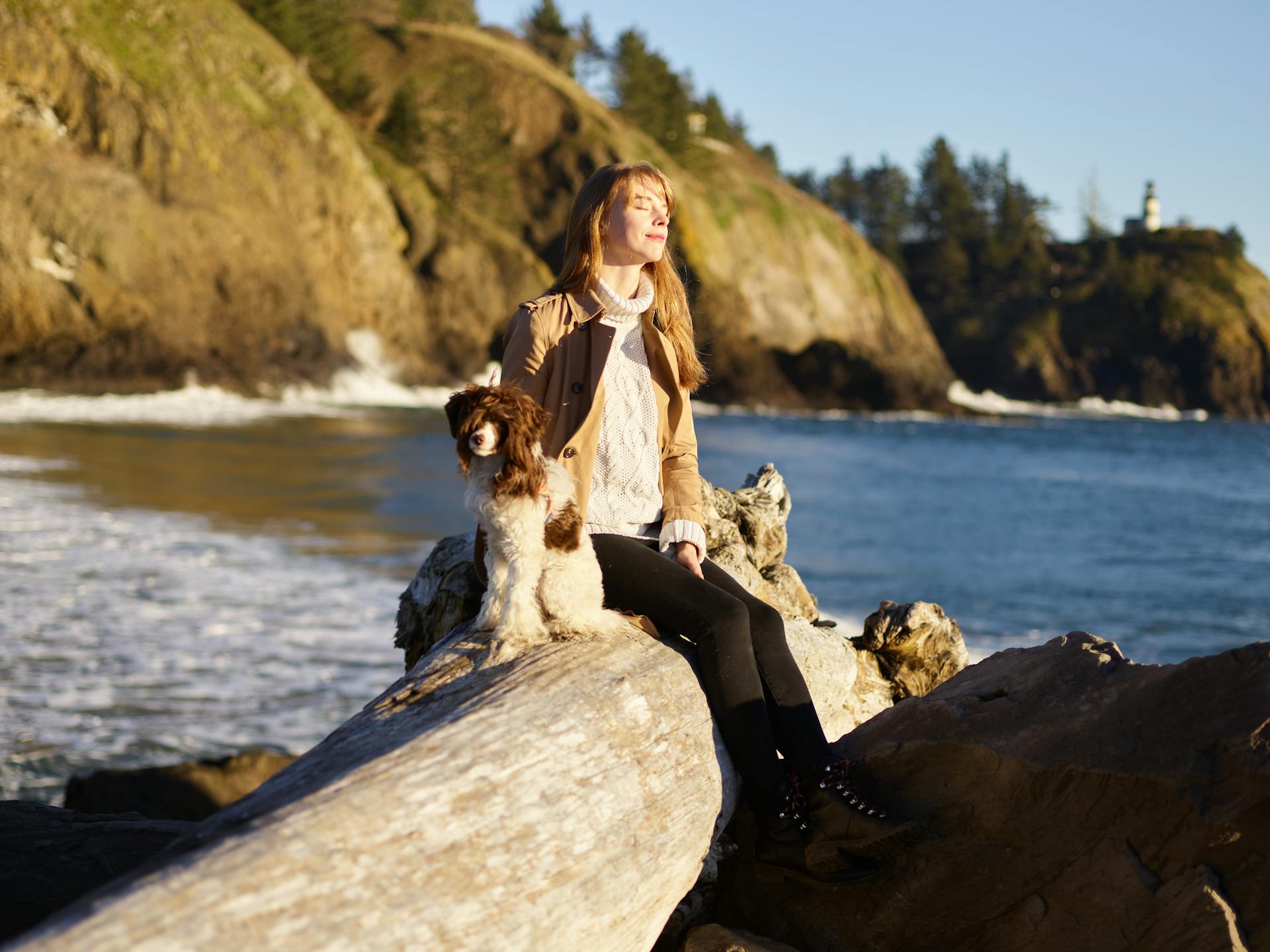
If you're looking for a small and hypoallergenic designer dog breed, you've come to the right place. These adorable dogs are perfect for families with allergies or those who want a low-maintenance pet.
The Cockapoo, for example, is a popular choice. This breed combines the gentle nature of a Cocker Spaniel with the intelligence of a Poodle, making it an ideal family pet.
With a weight range of 10-20 pounds, the Cockapoo is small enough to fit into any living situation. Its low-shedding coat also makes it a great option for those with allergies.
The Schnoodle is another great option. This breed is a cross between a Schnauzer and a Poodle, and it's known for its low-shedding coat and friendly temperament.
What Does It Mean?
So, what does it mean for a dog to be hypoallergenic? Hypoallergenic dogs are breeds that produce fewer allergens, making them a great option for people with allergies.
These dogs have a single layer coat or produce less dander, which is the main culprit behind dog allergies.
Some examples of designer dog breeds that are small and hypoallergenic include the Cockapoo and the Schnoodle, which are both crossbreeds between a Poodle and another breed.
These breeds are often created by crossing a Poodle with another breed to combine the low-shedding trait with the desired characteristics of the other breed.
The result is a dog that is not only low-maintenance but also affectionate and playful, making them a great companion for many families.
While no dog is 100% hypoallergenic, these breeds are a great option for those who want to bring a furry friend into their home without exacerbating allergies.
Discover more: Low Protein Food for Dogs Homemade
Small and Hypoallergenic Breeds
The Maltese is one of the best hypoallergenic dogs for kids, with a hair coat that sheds very little. They're a popular choice for families with allergies.
The Bichon Frise is another small and hypoallergenic breed, with a single coat that sheds very little. They require regular grooming to prevent matting.
A unique perspective: Shiba Inu Coat
The Bolognese is a small breed with a hair coat that sheds very little, making them a great choice for families with allergies. They're also known for being gentle and affectionate.
Here are some small and hypoallergenic breeds that are worth considering:
The Shih Tzu is also a small and hypoallergenic breed, with a hair coat that sheds very little. They require regular grooming to prevent matting and tangling.
The Yorkshire Terrier is another small breed with a hair coat that sheds very little, making them a great choice for families with allergies.
Hair Versus Fur
Dog hair sheds less frequently than dog fur because dog hair doesn't have a set length. It can grow and grow without shedding.
Dogs with fur coats, on the other hand, have a set length. Once the fur reaches that length, it sheds out and takes those dander and saliva proteins with it.
Dogs with hair coats need more frequent grooming than dogs with fur coats to keep the hair from getting tangled. Regular brushing can also help keep allergens low since it removes dead hair and dander.
Check this out: Dogs Hair Standing up and Tail Wagging
Some dog breeds have a single coat of curly hair that forms a relatively tight coil. When they shed, the shed hairs often fall back into the coat instead of on your furniture.
Here are some examples of dog breeds with low-shedding hair:
- Afghan Hound (hair coat, single coat)
- Aussiedoodle (low-shedding and hypoallergenic coats)
- Barbet (curly hair coat, low shedding)
- Bedlington Terrier (curly hair coat, low shedding)
- Bichon Frise (hair coat, single coat, low shedding)
- Maltese (hair coat, low shedding)
- Shih Tzu (hair coat, single coat, low shedding)
- Soft-coated Wheaten Terrier (hair coat, single coat, low shedding)
Poodle
The Poodle is a popular breed known for its low-shedding coat, making it a great choice for people with allergies. They come in a range of sizes, from Toy to Standard, and are often mixed with other breeds to create "doodles" that are also hypoallergenic.
Poodles have a single fur coat that's similar in texture to wool and doesn't shed much. This makes them a great option for families with allergies. They're also highly intelligent and easy to train, which is why they're often used as therapy dogs.
Some popular Poodle mixes include Goldendoodles, Labradoodles, and Schnoodles. These breeds are created by crossing a Poodle with another breed, often a Golden Retriever or Labrador Retriever. They're known for their low-shedding coats and friendly, outgoing personalities.
Recommended read: How Often Flea Treatment Dog
Regular grooming is essential for Poodles to prevent matting and tangling of their fur. They require regular brushing and clipping to keep their coat in good condition. This can be a bit of a challenge for some owners, but many find it to be a fun and rewarding experience.
Here are some popular Poodle mixes:
- Goldendoodles (Poodles and Golden Retrievers)
- Labradoodles (Poodles and Labrador Retrievers)
- Bernedoodles (Poodles and Bernese Mountain Dogs or Saint Bernards)
- Aussiepoos (Poodles and Australian Shepherds)
- Schnoodles (Poodles and Miniature Schnauzers)
- Cockapoo (Poodles and Cocker Spaniels)
- Maltipoo (Poodles and Maltese)
- Cavapoo (Poodles and Cavalier King Charles Spaniel)
Regardless of the Poodle mix, regular grooming and regular cleaning of your home can help minimize allergens and keep your home clean and comfortable for everyone.
Intriguing read: Dog Home Boarding
Stay Groomed
Regular grooming is essential for small and hypoallergenic breeds to reduce dander and keep their coats clean.
For curly-coated breeds like Poodles, regular grooming is crucial to prevent matting and tangling of their fur. In fact, Poodles need lots of care paid to their curls so they don’t become tangled and matted.
Some breeds, like the Portuguese Water Dog, require regular trimming and hand-stripping to keep their coats under control. They also need to be bathed every four to six weeks to keep their coats clean.
A fresh viewpoint: Do Small Dogs Need Small Breed Food
Hypoallergenic dogs should be groomed every week to reduce dander and keep their coats clean. Using a special shampoo like Allerpet Dog Dander Remover can help reduce pet dander for those allergic to dogs.
Here are some breeds that require regular grooming:
Regular grooming not only keeps your small and hypoallergenic breed looking its best, but it also helps reduce dander and keep your home clean.
Designer Breeds and Their Mixes
Designer breeds and their mixes can be a great option for those looking for small, hypoallergenic dogs. Poodles, in particular, are a popular choice due to their low-shedding, curly coat that holds dander and allergens near the skin.
Many Poodle mixes are also hypoallergenic, such as the Schnoodle, which combines a Schnauzer and a Poodle, and the Shih-Poo, a cross between a Shih Tzu and a Poodle. These mixes can make great pets for those with allergies.
Some popular Poodle mixes include the Goldendoodle, Labradoodle, Bernedoodle, and Maltipoo. These breeds are often low-shedding and hypoallergenic, making them a great option for those with allergies.
Poodle Mixes
Poodle mixes are all the rage, and for good reason - they're often hypoallergenic, intelligent, and adorable. Poodles themselves are considered the original hypoallergenic dog, with a single fur coat that's the texture of wool and doesn't shed.
One of the benefits of Poodle mixes is that they can inherit the Poodle's low-shedding coat. For example, the Schnoodle combines a Schnauzer and a Poodle, resulting in a coat that's always low-shedding. The Whoodle, a mix of a Soft-Coated Wheaten Terrier and a Poodle, is another example of a Poodle mix that doesn't shed very much.
Some popular Poodle mixes include the Goldendoodle (Poodles and Golden Retrievers), Labradoodle (Poodles and Labrador Retrievers), and Maltipoo (Poodles and Maltese). These mixes are often created to combine the best qualities of both parent breeds, including intelligence, affectionateness, and low-shedding coats.
Here are some popular Poodle mixes and their characteristics:
As with any dog, it's essential to research the parent breeds and the mix itself to ensure you're getting a dog that's a good fit for your lifestyle. And, of course, regular grooming is a must for Poodle mixes to prevent matting and tangling of their beautiful curls!
Which Are?
Some designer breeds that are considered hypoallergenic include the Cockapoo, which is a mix of a Cocker Spaniel and a Poodle.
These dogs tend to shed less than other breeds, making them a good fit for people with allergies.
Other Small Hypoallergenic Breeds
If you're looking for small hypoallergenic breeds, you'll love the Biewer Terrier, which has a hair coat. The Bolognese is another small breed with a hair coat, making it a great option for those with allergies. The Bichon Frise is a low-shedding breed with a single coat, perfect for apartments or homes with limited space.
The Maltese is one of the best hypoallergenic dogs for kids, with a hair coat and low shedding. The Lowchen is another small breed with a hair coat and low shedding, making it a great choice for families with allergies. The Shih Tzu is a friendly and outgoing breed with a single coat, low shedding, and a hair coat.
Here are some other small hypoallergenic breeds to consider:
The Yorkshire Terrier is a spunky breed with a hair coat, making it a great option for those with allergies.
Understanding and Choosing a Breed
Choosing the right hypoallergenic dog breed can be overwhelming, especially if you're new to dog ownership. It's essential to research your potential breed thoroughly before making a decision.
Some dogs require more exercise, maintenance, or social interaction than others, so it's crucial to consider these factors when selecting a breed. Spending time with a potential dog can help ensure there won't be an adverse reaction.
To make the process easier, consider the following characteristics of hypoallergenic dogs: low shedding, single coats, and hairless breeds. These traits can help reduce the amount of dander and allergens released into the air.
Here are some examples of hypoallergenic dog breeds that are small in size: Maltese, Bichon Frise, and Yorkshire Terrier. These breeds have low-shedding hair coats or are hairless, making them suitable for people with allergies.
The key is to find a breed that fits your lifestyle and needs. By doing your research and spending time with a potential dog, you can make an informed decision and find the perfect hypoallergenic family pet.
You might enjoy: How to Buy a Shiba Inu Dog
Single Coats vs Double Coats
If you or a family member has allergies, look for a dog with a single coat. These dogs shed less overall, and many have hair coats rather than fur.
Some single coated dogs include breeds like Poodles and Schnauzers, who are known for their low-shedding qualities.
Double coated dogs, on the other hand, have a longer outer coat of fur or hair and a dense furry undercoat that keeps them warm and protected from the elements.
Dogs like Golden Retrievers, Newfoundlands, and Labrador Retrievers are examples of double coated breeds that may not be the best fit for households with allergies.
Double coated dogs shed more than single coated dogs, which can exacerbate allergy symptoms.
Spitz breeds like Huskies and Pomeranians, collie breeds like Rough Collies and Border Collies, and herding breeds like German Shepherds and Australian Shepherds are also double coated breeds.
How to Choose the Right
Spending time with a potential dog is crucial to ensure it's the right allergy-friendly fit. Research your potential breed thoroughly before making a decision.
Some dogs need more exercise, maintenance, or social interaction than others. It's essential to consider these factors when choosing a hypoallergenic dog.
Dr. Callie Harris, a Purina veterinarian, recommends spending time with a pet before adopting to help ensure there won't be an adverse reaction. This is a crucial step in the process.
Don't rush into adopting a dog without considering your lifestyle and needs. Take the time to observe and interact with the dog to ensure it's a good fit for your family.
On a similar theme: Boarding Your Dog for the First Time
Keep Your Healthy
Keeping your hypoallergenic dog healthy is crucial, and one way to do that is with regular grooming. Regular grooming can help reduce shedding and prevent matting, which can be a problem for dogs with curly or wire coats.
Hypoallergenic dogs still require regular veterinary care, just like any other dog. This includes annual check-ups and vaccinations to prevent illnesses.
Some hypoallergenic breeds, like the Poodle and the Portuguese Water Dog, have a low-shedding coat that requires regular brushing to prevent matting. Other breeds, like the Schnauzer and the Soft-coated Wheaten Terrier, have a single coat that sheds very little.
Curious to learn more? Check out: Shiba Inu Grooming
Here are some hypoallergenic breeds that are known to be generally healthy:
Regular exercise and a balanced diet are also essential for maintaining your dog's overall health. This can help prevent obesity and other health problems.
By following these tips and being aware of your dog's specific needs, you can help keep your hypoallergenic dog healthy and happy.
Readers also liked: Why Are My Dog's Nails Splitting?
Doodles and Their Variations
If you're considering a small, hypoallergenic dog, you might want to look into Doodle breeds. Aussiedoodles, for example, are a cross between an Australian Shepherd and a Standard or Miniature Poodle.
They're very smart and very energetic, needing lots of exercise and mental stimulation to keep them happy. If they become bored, they can be destructive.
Aussiedoodle
The Aussiedoodle is a cross between an Australian Shepherd and a Standard or Miniature Poodle. This unique mix makes them very smart.
Their intelligence is matched by their high energy levels, which are inherited from both parent breeds. Aussiedoodles need lots of exercise and mental stimulation to keep them happy.
If they don't get enough physical and mental activity, they can become bored and destructive. This can lead to some serious problems, so it's essential to provide them with plenty of opportunities to run around and learn new things.
Aussiedoodles are also known for being hypoallergenic, which is great news for people with allergies. Their low-shedding coat is a result of their Poodle heritage.
Are Doodles?
Are Doodles hypoallergenic? No dog is 100 percent hypoallergenic, so if you suffer from severe allergies, you might want to try volunteering at a pet shelter or visiting a local dog park to see how you feel around different breeds of dogs.
Poodles are widely accepted as hypoallergenic dogs, but it's hard to determine how hypoallergenic a poodle-mixed dog is. One litter of doodle puppies can have an infinite combination of hypoallergenic versus non-hypoallergenic pups.
You can't know for sure without genetic testing how hypoallergenic a poodle-mixed dog is, because it's hard to determine how much of the poodle parent and how much of the other breed parent are present in the offspring.
So, if you're allergic and considering a doodle, be aware that it's a bit of a mystery.
Here's an interesting read: Dogs That Look like Goldendoodles
Sources
- https://rockykanaka.com/hypoallergenic-dogs/
- https://spotpet.com/blog/breed-tips/hypoallergenic-dog-breeds
- https://www.petmd.com/dog/general-health/hypoallergenic-dogs
- https://dogtime.com/reference/132592-hypoallergenic-dogs-best-dog-breeds-that-dont-shed-allergies-pet-dander
- https://www.womansday.com/life/pet-care/g25440167/dogs-that-dont-shed/
Featured Images: pexels.com


